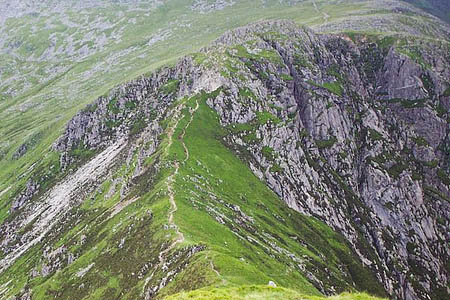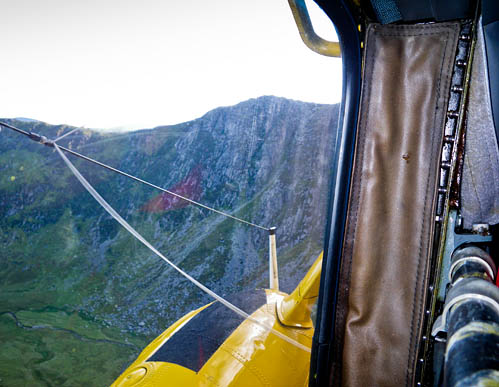Three climbers were rescued from a Snowdonia crag in an operation lasting more than 11 hours after their leader injured himself in a fall.
The three were tackling a route on the east face of Carnedd Llewelyn when the accident happened.
Ogwen Valley Mountain Rescue Organisation was alerted at 4.45pm on Saturday after one of the rock-climbers rang for help.
Chris Lloyd of the rescue team said: “Three rock-climbers from north-east Wales left their car in the Ogwen Valley and walked up Cwm Llugwy, over the bwlch into Cwm Eigiau to climb the classic Amphitheatre Buttress.
“Having scrambled down the ill defined bilberry-covered path to the foot of the 300m crag, they found a couple of parties ahead of them on the climb. They decided to look for an alternative classic route and chose Great Gully.
“Half way up this wet, vegetated, friable gully the sides converge to the Door Jamb or Converging Walls, one of which is overhanging, the other wet.
“There is an escape to the right, which the leader took. He seems to have moved too far to the right and whilst trying to regain the gully line took a 10m [33ft] or so fall, pulling out a couple of runners. In the process, he dislocated his left shoulder, but was otherwise uninjured. He could not get back to his two colleagues and they could not get to him.”
Mr Lloyd said one of the climbers was able to get a mobile signal and summon help.
“The team was called and a ground party immediately set off up Cwm Llugwy. The assistance of 22 Squadron [from RAF Valley] was requested and granted, as we didn’t know exactly where the party were,” he added.
“After a recce of the crag, the helicopter crew located the three and realised that helicopter evacuation from that location was not possible. The helicopter airlifted the ground party of four to the top of the crag, returning to Oggi Base to pick up a further six with the heavy rescue kit.
“We soon realised that the 400m of rope we had with us was insufficient, so two members returned to Ogwen valley to pick up another 200m of rope. Meanwhile, to aid communications, a vehicle was sent around to the Conwy valley and up into Cwm Eigiau.
“The team was lowered and abseiled down the gully to near the casualty. Members had to traverse across to the casualty and carry out treatment before getting him back into the gully line.
“All three were then abseiled and lowered to the screes below, followed by 10 team members from the crag. Here they were met by the ‘catering division’ which had brought supper – it was now 1am.”
The Sea King crew then returned to the floor of the cwm half an hour later to airlift the injured climber to the Ysbyty Gwynedd in Bangor.
A second Ogwen Valley MRO Land Rover drove up to Cwm Eigiau and the two vehicles took the two remaining climbers, team members and kit back to the team’s base at Bryn Poeth for a 6am cooked breakfast.
One team member’s wife had earlier delivered his supper of lasagne, on horseback, while he was parked up high above the entrance to the cwm to provide communications link.
The rescuers also thanked the occupants of the climbing hut at Eigiau Cottage for a supply of tea and food to the Land Rover drivers who were awaiting the ground party.
Mr Lloyd said: “The remaining two left on the top of the crag were resupplied by two team members. Once it was decided that the casualty was to be evacuated down the crag, top ropes were recovered and stashed along with stretcher and casualty bag for recovery the following day.
“The four descended, with two driving round to Cwm Eigiau to relieve the communications link.
“Later on Sunday, after three hours sleep and a lot of washing of muddy kit, four members walked back up to the top of Craig yr Isfa to recover the ropes and stretcher.”
He appealed for any climbers using the routes to look out for gear left during the rescue. “During the casualty evacuation down the gully, a climbing rope belonging to the casualty and a number of chocks were abandoned,” he added.
“Should anyone venture up the Great Gully in the near future and recover this gear, we would appreciate its return to OVMRO. Just remember, the next time we need it, it might be for you!”
Later on Sunday, the casualties returned to Oggi Base to thank the team. Mr Lloyd said: “This was an unfortunate accident that could have happened to anyone. But it certainly gave the team members a night to remember.”
The team had earlier been in the same area, when two ill equipped walkers found themselves in difficulty late on Friday evening when cloud came down.
Mr Lloyd said the two women had set off on a walk up Cwm Eigiau, intending to cross the ridge to the adjacent parallel Cwm Dulyn.
“As they climbed up onto the boggy plateau, they were engulfed in heavy cloud. They continued in what they thought was the right direction but as the cloud lifted they found themselves looking down crags towards Llyn Eigiau.”
The women rang for help at 8.30pm.
The rescue team’s spokesman said: “Tired and scared, they telephoned for assistance. They were found, with no torch, whistle, map, compass or rucksacks at dusk and escorted down to safety by midnight.”


mr Philip Nevin
26 July 2011Mountain adventure is a risk, walking / scrambling or climbing.
Training is very important - makes one aware of possible dangers.
In the early seventies began adventure training: hill walking, rock climbing, dinghy sailing & pony trekking - generally in N & S Wales.
Now 51, still active on the mountain scene.
Mountain rescue is very important service along with millitary Royal Air Force / Royal Navy Seaking helicopter support,
Have been involved in a mountain accident in February 1999, on Ben Lui (Scotland). A friend fell 100ft off a buttress in snow & ice conditions.
P, Nevin